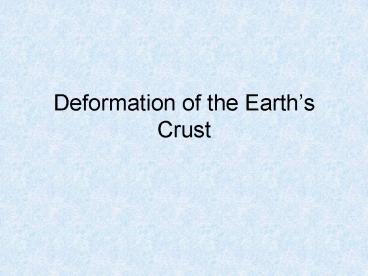Deformation of the Earths Crust - PowerPoint PPT Presentation
1 / 21
Title:
Deformation of the Earths Crust
Description:
Deformation is most commonly a result of plate tectonics ... Venetian Subsidence. Subsidence. Rebound of the crust from Weathering ... – PowerPoint PPT presentation
Number of Views:543
Avg rating:3.0/5.0
Title: Deformation of the Earths Crust
1
Deformation of the Earths Crust
2
What is deformation?
- Bending, tilting, and breaking of the Earths
crust - Deformation is most commonly a result of plate
tectonics - But, another means of deforming the Earths crust
results from Isostacy
3
(No Transcript)
4
What is Isostacy?
- It is the balance between two forces the crust
pressing down on the mantle and the mantle
pushing up on the crust - The balance between these two forces is when the
two forces are at equilibrium, the crust moves
neither up or down
5
Mechanics of Isostacy
- If an object is floating, and mass is added to
it, or it becomes thicker, the object will sink. - If an object is floating, and mass is removed, or
it becomes thinner, then more of the object will
float.
6
(No Transcript)
7
Isostatic Adjustment
- Ways that the crust can gain more mass
- deposition of sediment, addition of mountains
or volcanism, glaciation - Ways that the crust can loose mass weathering,
glacial rebound
8
Deposition of Sediment
9
Venetian Subsidence
10
Subsidence
11
(No Transcript)
12
(No Transcript)
13
Rebound of the crust from Weathering
14
Formation of the Appalachians
15
1811 New Madrid, Missouri earthquake
- In the top three of largest earthquakes to strike
North America - At least 8.0 magnitude
- Changed the course of the Mississippi river,
toppled trees, swallowed farms..
16
(No Transcript)
17
Why an earthquake in Missouri?
- North America is bending back to normal, crustal
rebound. - As the Appalachians undergo weathering, they are
getting lighter, so the crust in that location is
moving back up. - Another cause besides weathering.
18
(No Transcript)
19
(No Transcript)
20
(No Transcript)
21
Glacial Rebound
- During ice ages, the continents become covered
with thick extensive ice sheets that weight down
the crust, eventually warping it. - When the glaciers retreat and melt, the crust
rebounds and tries to bend back to normal.































